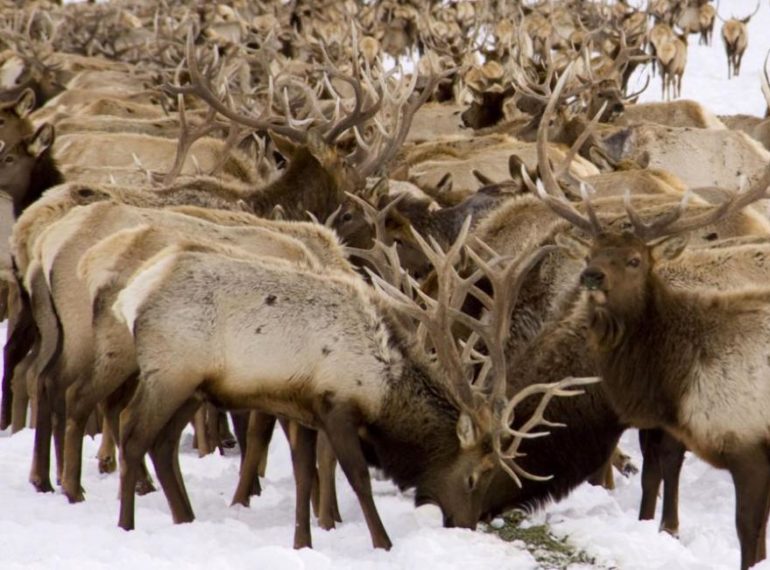DENVER, Nov. 27 (UPI) — Wyoming’s National Elk Reserve could become a toxic “biological Superfund site” polluted by deadly prions that cause chronic wasting disease, if wildlife officials keep feeding thousands of elk every winter, wildlife conservationists say.
The concentration of large numbers of elk over the winter may accelerate the spread of the incurable and fatal “zombie deer” disease to catastrophic levels near the Yellowstone ecosystem and could eventually destroy Wyoming’s multimillion-dollar big-game hunting industry.
Because prions can remain for years in soil, Wyoming’s feedgrounds could become “de facto biological ‘Superfund’ sites contaminated with infectious prions,” retired U.S. Fish and Wildlife Service biologist Bruce Smith said in a statement.
The Western Association of Fish & Wildlife Agencies’s 2018 chronic wasting disease adaptive management plan calls for state wildlife agencies to eliminate points at which members of the deer family congregate, including feeding sites.
The highly contagious and deadly disease has no cure and has spread through elk, deer and moose populations in 26 states.
Last year, Judge Nancy Freudenthal of the U.S. District Court for the District of Wyoming cited chronic wasting disease when she ruled that state wildlife officials should close a feeding ground for thousands of elk east of Jackson Hole.
But the Wyoming Department of Game and Fish enacted an emergency provision to phase out the feeding grounds over five years, or possibly 10, which wildlife biologists fear could be too slow as chronic wasting disease marches west across the state.
“Game and Fish agents spread the food on the ground, and since there’s free food there, the elk essentially spend the entire winter walking around in their feces and urine in just the same way cattle do at a feedlot,” said Jonathan Ratner, regional director for Western Watersheds Project.
His group, along with the Sierra Club and Wyoming Wildlife Advocates, sued state and federal wildlife officials to close the feeding grounds.
“When chronic wasting disease hits these feedlots, it will explode into contamination,” he said.
Wyoming’s western feeding grounds include the National Elk Reserve, run by the U.S. Fish and Wildlife Service and others operated by state wildlife agents.
Feeding the elk by private parties started a century ago after a severe winter in 1908, when thousands of the animals starved to death. The Game and Fish Department spends more than $2 million per year providing hay for elk throughout the winter at feeding areas.
Moreover, an overpopulation of elk draws big-game hunters and outfitters in a $300 million industry.
Along with the National Elk Refuge, where about 7,000 elk gather over the winter to munch on free food, an additional 22 other feeding grounds on public lands attract thousands more around Jackson Hole.
Wildlife activists who filed lawsuits believe there is enough forage material in the forests around Jackson Hole to feed elk over the winter, but Game and Fish agents say cutting the elk off immediately could lead to starvation of thousands and impact the state’s lucrative hunting season.
Highest concentrations
Wyoming deer and elk have tested positive for chronic wasting disease for 30 years. The state has the highest concentrations of the disease in the country, mostly in the southeast corner near the Colorado border.
Now, the disease is spreading west over the continental divide, and recently was discovered in Grand Teton National Park and about 40 miles from the Yellowstone ecosystem in the northwest portion of Wyoming.
A mule deer infected with chronic wasting disease was found this fall at one of the elk feeding grounds.
Similar to “mad cow”
Chronic wasting disease is a form of spongiform encephalopathy, similar to mad cow disease and scrapie in sheep in the United Kingdom and Creutzfeldt-Jakob disease in humans. It is caused by misshapen proteins, called prions, that build up in the spine and brain, causing brain damage and death.
While a deer or elk can look perfectly healthy for more than two years with the disease, the animal eventually will become emaciated and confused, stumbling and drooling with a droopy head and ears.
Prions are spread from one deer to another via saliva, urine or feces, scientists believe.
While no documented case of humans contracting chronic wasting disease have been reported , some epidemiologists believe there’s a chance the disease could jump species to humans who eat infected venison.
Every year, Americans eat venison from up to 15,000 animals infected with the disease, according to estimates from a 2017 study from the Alliance for Public Wildlife.
The Centers for Disease Control and Prevention advises people not to eat venison from infected animals. The agency warns there might be a long incubation period, similar to that for mad cow disease, which showed up in British beef eaters 10 years after they consumed infected meat. No cases of chronic wasting disease have been found in U.S. cattle.
Some studies show a chronic wasting disease population crash of elk and deer could take place within 40 years.
Photo: Mark Gocke Wyoming Game and Fish Department
RELATED ‘Zombie’ deer disease might put humans at risk, epidemiologists say
RELATED Fatal disease similar to mad cow spreading in America’s deer
RELATED Yellowstone bison hunt generates controversy, court battle

